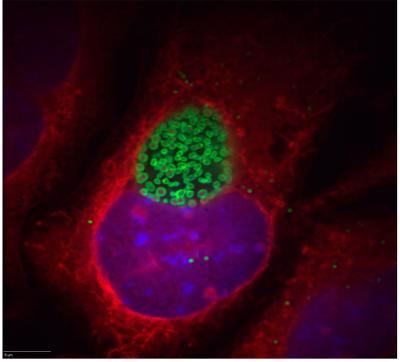
Credit: Hefty Lab
LAWRENCE — According to the Centers for Disease Control and Prevention, chlamydia trachomatis is the most commonly reported sexually transmitted bacterial disease in the U.S., totaling 1.7 million cases in 2017. Rates are highest among teenagers and young adults. Left untreated, chlamydia can cause blindness and sterility. Beyond the U.S., chlamydia is the leading sexually transmitted bacterial infection worldwide.
A recent paper by a team of molecular biologists headquartered at the University of Kansas pinpointed a gene that allows chlamydia to take up DNA from its host environment.
“Right now, the main antibiotics to treat chlamydia are doxycycline and azithromycin, but these are similar to what you’d take for back acne or a respiratory infection, respectively,” said lead author Scott LaBrie, a doctoral student in the Department of Molecular Biosciences at KU. “Those drugs not only affect chlamydia, but they also affect lots of other microbes, including your microbiome. So, while there are sufficient drugs out there to eliminate your chlamydia infection, you’re also potentially disrupting your natural flora. Developing a therapeutic that can be specific to chlamydia is of pretty large importance. We’re learning more and more that homeostasis of your gut, of your body’s microflora, that’s important for health.”
LaBrie’s collaborators in the research presented in mBio were KU graduate students Zoë Dimond, Kelly Harrison, Srishti Baid, postdoctoral scientist Jason Wickstrum, and with P. Scott Hefty, professor of molecular biosciences. The KU researchers from the Hefty Lab also worked with co-author Robert Suchland of the University of Washington.
“In order to cause disease, chlamydia must enter a host cell and protect itself from host defenses while also replicating in large numbers so that it can spread to surrounding cells,” corresponding author Hefty said. “The mechanisms that many bacteria utilize to cause disease are often acquired by sharing and taking in new DNA, the molecule that makes up an organism’s genes. Until now, it has not been well understood how chlamydia acquires new DNA. However, using a novel genetic tool, this paper identified a gene that allows chlamydia to obtain new DNA from its surrounding environment.”
The research team used a genetic tool called “transposon mutagenesis” that generates a mutation in a single gene. The researchers disrupted more than 80 genes in the chlamydia bacterium’s chromosome, then observed effects on growth and infection.
“There’s roughly 1,000 genes that can potentially be disrupted,” LaBrie said. “There haven’t been very many genetic tools developed to investigate the basic biology of chlamydia. So, this allows us to randomly disrupt individual genes — then investigate what the effect is or the phenotype. That can then highlight the importance of that gene and the role that it might play in the organism’s ability to cause disease.”
LaBrie compared testing the functionality of chlamydia at the molecular level to experiments on a military vehicle.
“That’s where this tool comes in,” he said. “I kind of equate it to a military Humvee. If you had no idea what that vehicle was for, you might be able to kick out its headlights. And then you would notice it only travels during the daytime, not at night. If you pop the tire, it might not go anywhere. Then if you knocked out its gun, it might drive all over the place, but it doesn’t kill anyone. That’s kind of what we’re doing with different pieces of Chlamydia — we’re knocking out different specific components, and then observing how that affects its ability to either replicate, or infect and get into the host cell, or how well it does in infecting the host overall.”
Using this process-of-elimination both in petri dishes and mouse models, the team isolated one critical gene in chlamydia that encodes a protein that acquires new DNA from its host environment, named “ct339.”
“The mutation in this gene provided the opportunity to generate evidence that without the intact gene, chlamydia could no longer acquire new genetic material that assists with adaptation to its environment, including host defenses,” Hefty said.
LaBrie called the research “foundational brickwork.”
“We hope this tool can highlight different genes and their products, which then could be targeted for therapeutics,” he said. “It might be that within this library of mutants there would be something that could come out as an absolute mechanism used for virulence that could be then targeted — either by some drug that could bind and inhibit that protein from carrying out its function, or by identifying something that’s on the surface that can be targeted for a vaccine. Overall, this is mostly basic science, but it could help develop targets for future therapeutics.”
LaBrie, who hails from Sacramento, California, and attended Haskell Indian Nations University for his undergraduate studies before coming to KU, said he hoped to earn his doctorate degree next spring. After that, he plans to relocate to Alaska with his wife where he aims to continue his research career.
###
Media Contact
Brendan M Lynch
[email protected]
785-864-8855
Original Source
https:/
Related Journal Article
http://dx.




